Week9 Blog ( 1 ) | Curation Project Improvements and Study Summary of “Publishing”
![{"data":{"activityName":"","pictureId":"2056C410-AA23-4F78-BE18-AC1077BF8DF3","capability_extra_v2":{"imageeffect":[{"effect_id":"1012192","origin":"heycan","resource_id":"6916783724277273101"}],"filter":[{"effect_id":"87689656","resource_id":"7429656172535222835","origin":"heycan"}]},"capability_key":["edit","filter","imageeffect"],"effect_id":"edit","appversion":"12.0.0","enter_from":"enter_launch","product":"retouch","stickerId":"","playId":"","os":"ios","filterId":"7429656172535222835","imageEffectId":"1012192","infoStickerId":"","effect_type":"tool"},"source_type":"douyin_beauty_me"}](https://blogs.ed.ac.uk/s2648436_curating-2024-2025sem2/wp-content/uploads/sites/11134/2025/03/IMG_6685.jpeg)
⚫️Study Summary of “Publishing” Lecture by Adam
The concept of publishing as curating
Publishing is not merely the act of delivering a text from the printing press into readers’ hands; it is itself a curatorial gesture—extending the reach of an artistic practice through editing, layout and distribution, no longer confined to traditional exhibition spaces but rather “making new impressions on the skin of the social”.
Key theoretical frameworks
“Sociology of emergences”: the symbolic amplification of nascent, fragmented signs and tendencies, giving rise to new semantic landscapes.
Cognitive Justice: the struggle for the coexistence of diverse knowledges, challenging the strict divide of “no knowledge beyond belief” and insisting that all forms of cognitive practice be recognised and amplified.
Temporary Utopias: borrowing the 1970s feminist curatorial strategy of “creating provisional utopias in the here and now,” using publishing to build practical models and imagined communities.
Ontological Turn: moving beyond institutional critique towards revealing multiple modes of being, positioning publishing as a platform for presenting new ways of existing.
Phenomenology and Queer Phenomenology: drawing on Husserl’s suspension of presuppositions and Sara Ahmed’s notion of “orientation,” viewing publishing as an act of “facing” particular experiences and shaping collective attention.
Case studies
Case 1 – Transmission Gallery, The Phone Is the Keyhole…
Produced by the first all QTIBIPOC committee, this publication, with its “backstage chaos” narrative, exposes the labour divisions and anxieties of traditional publishing, tracing a “line of refusal” in dissident editorial practice.
Case 2 – LUX Scotland Moving Image Festival publication
Written in the present tense to extend the festival beyond its weekend duration, and deliberately interspersed with blank pages, this edition both challenges conventional layouts and embodies the tension between deterritorialisation and reterritorialisation.
Case 3 – Serpentine’s How We Hold
Bringing together community engagement, educational practices and creative methodologies, this book functions as both toolkit and discursive intervention, extending the lifespan of public programmes and fostering a collective imagination grounded in care and resistance.
Conclusion
Publishing as curating reimagines the printed page as a vehicle for text, not just as a vehicle for text, but as an extension of the exhibition space itself—an active gesture of editing, typography, and distribution that “carves new marks on the social surface.” The catalogue itself can function as a curator by amplifying nascent fragmented signs (“emergent sociology”), asserting epistemic justice by acknowledging multiple knowledges, and drawing on feminist strategies of provisional utopias and ontological turns. It demonstrates a collective orientation (in the sense of phenomenology and queer phenomenology) to experiences that might otherwise be marginalized. Case studies such as Transmission’s QTIBIPOC exhibition, LUX’s Present Tense publications, and the Serpentine’s How We Hold, show how print mobilizes discourses of refusal, care, and decolonization to reshape print capitalism as a tool for radical collective action.
In the case of my Echoes of Silence project, perhaps the exhibition book could be supplemented with a collection of field recordings, participant reflections, and guiding prompts, using deliberate white space and non-linear layout to reflect the absence of sound and invite readers into a co-created archive—thus turning the exhibition book itself into a curatorial device that extends the exhibition’s sonic landscape into the realms of reading, writing, and shared imagination.
⚪️This week’s exhibition case
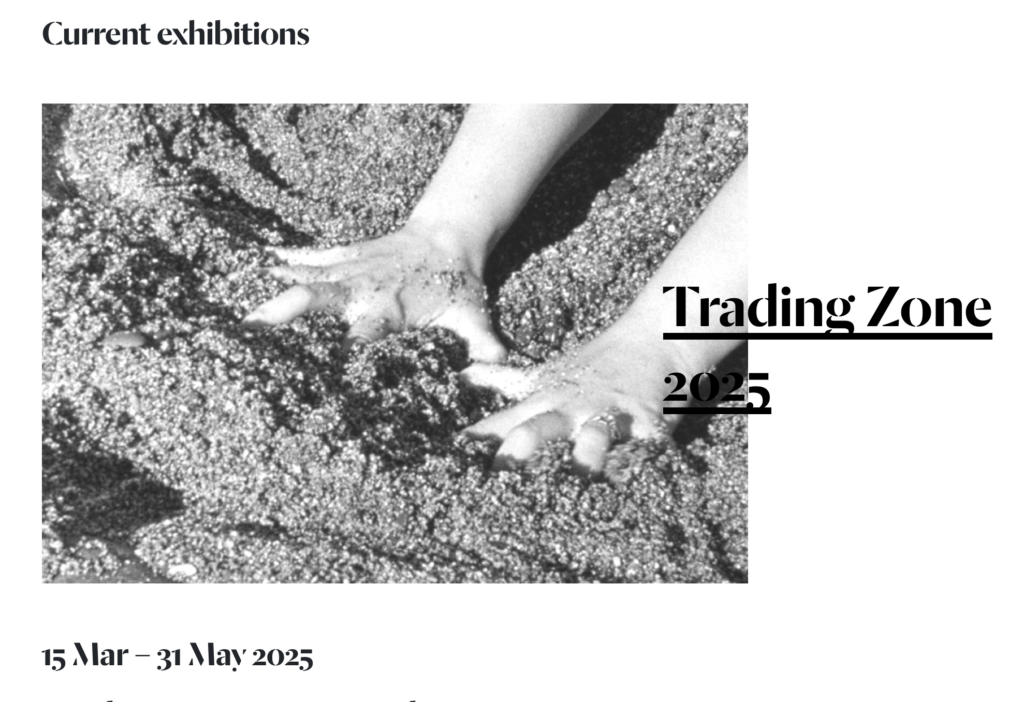
Trading Room 2025 exhibition poster.
Trading Zone 2025 is a cross-disciplinary group exhibition at Talbot Rice Gallery, showcasing experimental works by ten artists. Exploring themes like planetary relations, imagination, and institutional critique, it blurs boundaries between art and research, inviting viewers into a dynamic space of collaboration and speculation.
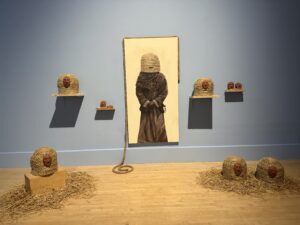
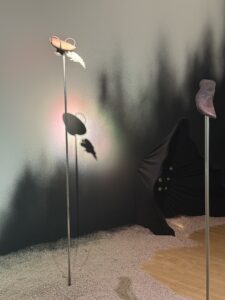
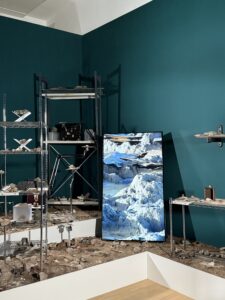

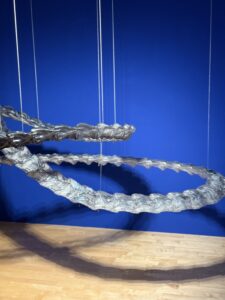
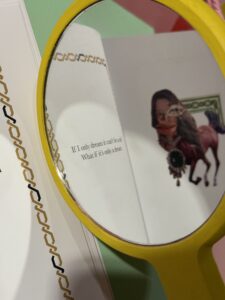
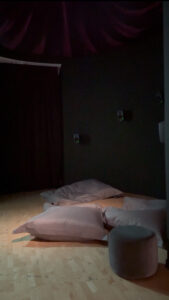
⚪️Use in my exhibition projects.
Among these works, the one that impressed me the most was PhD student Victoria Evans’s sound work Deep Space Call and Response.

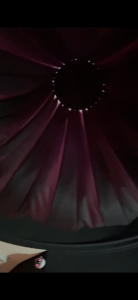 Video of Deep Space Call and Response
Video of Deep Space Call and Response
Inspired by Deep Space Call and Response, which draws on the movements of European Space Agency satellites to modulate domestic soundscapes, this exhibition similarly explores how deep listening can bridge the intimate and the systemic, revealing how women’s domestic lives are shaped by patriarchal structures. As Pauline Oliveros writes, “Deep Listening is intended to expand consciousness of sound in as many dimensions of awareness and attentional dynamics as humanly possible” (Oliveros, 2005), this project could encourage audiences to become aware of the sounds of silence, shame and surveillance embedded in women’s everyday experiences.
Reference
Ahmed, S. 2006. Queer Phenomenology: Orientations, Objects, Others. Durham, NC: Duke University Press.
Ahmed, S. 2023. The Feminist Killjoy Manifesto. London: Penguin.
Anderson, B. 1983. Imagined Communities: Reflections on the Origin and Spread of Nationalism. London: Verso.
Bhambra, G. K., Gebrial, D., & Nisancioglu, K. (Eds.). 2018. Decolonising the University: Power, Knowledge and the Politics of Education. London: Pluto Press.
Bodman, S. 2016. “An Artistic, Political and Social Alternative to Mainstream Publishing.” In A. Gilbert (Ed.), Publishing as Artistic Practice (2nd ed., p. 38). Berlin: Sternberg Press.
Condorelli, C. 2014. The Company She Keeps. London: Book Works.
Deleuze, G., & Guattari, F. 1987. A Thousand Plateaus: Capitalism and Schizophrenia. Minneapolis: University of Minnesota Press.
Egan, J., Gatens, L., Graham, E., Khalaf, A., & Thorp, A.
Evans, V., 2025. Deep Space Call and Response. Presented in Trading Zone 2025, Talbot Rice Gallery, University of Edinburgh, March-May 2025.
Oliveros, P., 2005. Deep Listening: A Composer’s Sound Practice. Nevada City, CA: Deep Listening Publications.
O’Hare, L. (n.d.). “Artists at Work: Nick Thurston.” Afterall. Retrieved April 2025, from https://www.afterall.org/articles/artists-at-work-nick-thurston/
Oxford English Dictionary. (2025). Entries for “ontology” and “phenomenology.” Retrieved from https://www.oed.com/
Santos, B. de S. 2018. “Decolonising Education.” In G. K. Bhambra, D. Gebrial, & K. Nisancioglu (Eds.), Decolonising the University (pp. 201–…). London: Pluto Press.
Talbot Rice Gallery, 2025a. Trading Zone 2025 exhibition poster. University of Edinburgh, Edinburgh.
Whittle, A. 2019. “Biting the Hand That Feeds You: A Strategy of Wayward Curating.” Critical Arts, 33(6), 110–123. https://doi.org/10.1080/02560046.2019.1688848



